Indonesian Moon
Part Three.
![]()
"I had learned many
years ago that a two-arm wave
means someone is in trouble."
![]()
After falling off the step I feathered the prop and Alex got out on the float to take a water sample. The water was as clear and pure as from any spring. I later teased Alex that he could quit flying for a living and start bottling and selling that water. “Alex’s Rinjani Spring Water.”
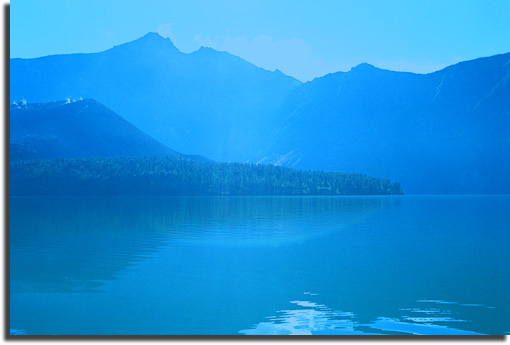
The feeling of having been the first
person ever to land on this lake and possibly the first person to ever
have even been on the water, as there was no evidence of a boat, did not
sink in while we floated on the beautiful lake. All I could think of was
getting airborne again. As soon as Alex was strapped in I applied full
power and started my takeoff run. Although I was getting full power on the
torque I was not getting full thrust from the bite of the prop. The thin
air was certainly affecting both thrust and lift. I had to use every tiny
bit of my floatplane experience to coax my baby up onto the step.
Before applying full power, I pulled the
control column right back with full up elevator deflection. The nose rose
agonizingly slowly until it rose no more. At this point I relaxed the
pressure on the control column allowing the nose to drop slightly. This
helped the prop to “pull” the aircraft onto the step changing the
center of buoyancy from the rear of the floats toward the center and
allowing the airflow to build up over the wings creating lift. As the
buoyancy moved forward I could feel the force of the water starting to
push the aircraft onto the step and so I rocked the control slightly ahead
to “help” her fulcrum her way into the hydroplaning attitude.
As soon as she gained the step I pulled
back gently on the control column again to search for the “sweet spot,”
or the ideal attitude where neither the bows or heals are
digging or dragging and the aircraft is riding solely on the smallest
section of the V shaped keel. When she was ready to fly, I broke the right
and, almost simultaneously, the left float from the lake's surface tension
and was airborne. The rest was easy. Alex and I had earned our donuts that
day.
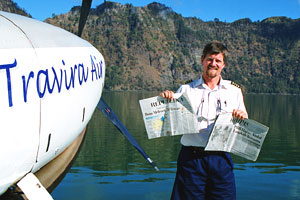 Oddly enough we savored our conquest and did not tell anyone for a couple
of days. When I finally ventured to mention to the head office in an “Oh,
by the way” conversation, they were ecstatic. I was congratulated with an
official fax from the head office thanking me for my effort. “For
Travira Air, your landing inside the Rinjani volcano is equivalent to
Indonesia landing a Man on the Moon.” They could hardly wait to see the
photographs.
Oddly enough we savored our conquest and did not tell anyone for a couple
of days. When I finally ventured to mention to the head office in an “Oh,
by the way” conversation, they were ecstatic. I was congratulated with an
official fax from the head office thanking me for my effort. “For
Travira Air, your landing inside the Rinjani volcano is equivalent to
Indonesia landing a Man on the Moon.” They could hardly wait to see the
photographs.
Alex and I looked at each other. We had no
photographs. Neither of us had brought a camera. As there were no
witnesses how were we to prove that we had actually landed on the lake? We
did not exist.
On a later conversation, the Operations
Manager lamented us not having photographs. He smoothed the way for a
second flight when he ask, “Do you think there is anyway that you could
get some pictures?”
I said, “Sure, let me work it out.”
 So two days later Alex and I were off again. This time on landing I shut
down the turbine and was left with an eerie silence as we ghosted to a
stop. Alex and I got out to document our landing for posterity. Alex had
come up with the idea that we should shoot each other holding newspapers.
He had even brought the original papers from the morning we had done the
first landing, as that would be more authentic. Now we could prove that we
had actually been there that morning. The irony was that the papers we
held carried stories in Indonesian about Bin Ladin and the Al Qaeda
shortly after the 9/11 attacks on America. We looked like hostages being
held for ransom.
So two days later Alex and I were off again. This time on landing I shut
down the turbine and was left with an eerie silence as we ghosted to a
stop. Alex and I got out to document our landing for posterity. Alex had
come up with the idea that we should shoot each other holding newspapers.
He had even brought the original papers from the morning we had done the
first landing, as that would be more authentic. Now we could prove that we
had actually been there that morning. The irony was that the papers we
held carried stories in Indonesian about Bin Ladin and the Al Qaeda
shortly after the 9/11 attacks on America. We looked like hostages being
held for ransom.
The morning was so beautiful and calm that
this time I did not want to leave. The opaque emerald green water was
cool, and the air was crisp and refreshing. The trees turned out to be
tall straight pine, looking like something out of Myst or descendants from
the Mesozoic Period, which blended in well with the alpine atmosphere. The
feeling was that of a summer morning in the Rocky Mountains. Alex said,
“I’ve never been to Canada, but I imagine that this is what it is
like.”
 I said, “Yes... except for the volcano” towering over the east end of
the lake. Silhouetted against the morning sun, I could make out the rising
steam from the volcano cone. The steam appeared thin and wispy from the
distance, but it was venting nonetheless. In other words, here was
evidence that the volcano was still active and threatening. It was hard to
believe that something so majestic and beautiful could be so potentially
dangerous. In the calm cool of the morning, the tension I felt was not
caused by the awareness of imminent death. The feeling was rather one of
unfulfilled opportunity, like that of not having said goodbye to a dying
father. I would be disappointed if Rinjani erupted one day and I was not
there to see it go. I certainly understand how a volcano could come to be
worshipped.
I said, “Yes... except for the volcano” towering over the east end of
the lake. Silhouetted against the morning sun, I could make out the rising
steam from the volcano cone. The steam appeared thin and wispy from the
distance, but it was venting nonetheless. In other words, here was
evidence that the volcano was still active and threatening. It was hard to
believe that something so majestic and beautiful could be so potentially
dangerous. In the calm cool of the morning, the tension I felt was not
caused by the awareness of imminent death. The feeling was rather one of
unfulfilled opportunity, like that of not having said goodbye to a dying
father. I would be disappointed if Rinjani erupted one day and I was not
there to see it go. I certainly understand how a volcano could come to be
worshipped.
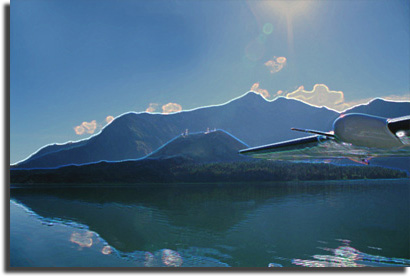 Because this flight was also booked as a training flight I let Alex take
over left seat so he could do a series of landings and takeoffs. I
already had
my fun. On the second takeoff we were flying out the cut toward home when
Alex looked down toward the campsite and said, “I think someone is mad
at us, they are waving with both arms.”
Because this flight was also booked as a training flight I let Alex take
over left seat so he could do a series of landings and takeoffs. I
already had
my fun. On the second takeoff we were flying out the cut toward home when
Alex looked down toward the campsite and said, “I think someone is mad
at us, they are waving with both arms.”
I had learned many years ago that a two-arm
wave means someone is in trouble. Much to Alex’s amazement I decide to
investigate. His reasoning was that if we were in trouble we should avoid
the person. My reasoning was that if we were in trouble we should confront
and reason with the person, but more likely we would be providing
assistance to someone who needs our help. Alex made his first glassy water
landing and we stepped taxied toward the shore. When he decided we were
getting close to the shore he pulled her off the step, but to both of our
amusement the waving person was a tiny little dot on the shoreline. We
were still a kilometer away. The clear air and magnitude of the mountains
had fooled our senses again.

We approached the shore and I had Alex shut down
the turbine early. We pulled out the aluminum paddles and slowly worked
our way toward the rocky shoreline. The bank was gradual making it easy to
nose in the aircraft. With no waves or tide to worry about we only had to
hitch a rope and leave her floating. The waver turned out to be Jaron
Starling from Australia.
Jaron was a backpacker who had hired some
local guides from the village below and set out alone to find this
legendary lake. He said it took him three days to get this far when one
of his guides came down with pneumonia. The poor guy had been holed up
in his tent for several days with no sign of improvement. Jaron said the
guy had a fever and could hardly breathe. He certainly did not want to
risk forcing him to hike three to four hours back up to the crater rim and then another
eight hours
back down to the village. Jaron was getting low on supplies and he was
concerned about his guide’s health. Could we possibly carry this sick
man back down to civilization?
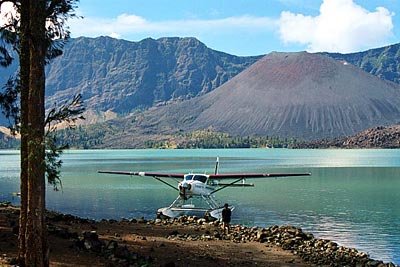 To me this sick man was a minor miracle. We weren’t supposed to be here in
the first place but he was our perfect reason for coming here. "We were
flying over and saw that someone was in trouble." That was the truth plain
and simple. We had no choice but to land.
To me this sick man was a minor miracle. We weren’t supposed to be here in
the first place but he was our perfect reason for coming here. "We were
flying over and saw that someone was in trouble." That was the truth plain
and simple. We had no choice but to land.
In fact, that is what I had
suggested to Travira Air when they wanted to know how we were going to get
official permission to start a tourist run into the lake. Sell it as a
safety backup for mountain climbers and hikers who might get in trouble
while they were on top. If we were to drop in a couple of times a week it
might even increase the amount of hikers willing to risk the journey
knowing that they could be rescued if necessary. Medical evacuations and
exploration started bush flying and here we could combine the two.
 I agreed to take the man as long as he could be ready by 9:30 a.m. It was
already 9:10 a.m., and the midmorning clouds were starting to fill the lower
valley and spill out through the cut into the lake. By 10 a.m. the crater
basin would be filled with clouds and we would be trapped. Jaron had the
guide packed and ready to go by my deadline. We loaded him on board and
Alex conducted a takeoff and spiral climb back toward the exit. Once
through the cut we started a descent, slowly as not to affect our
congested passenger, toward Mataram the capital of Lombok where we dropped
him off.
I agreed to take the man as long as he could be ready by 9:30 a.m. It was
already 9:10 a.m., and the midmorning clouds were starting to fill the lower
valley and spill out through the cut into the lake. By 10 a.m. the crater
basin would be filled with clouds and we would be trapped. Jaron had the
guide packed and ready to go by my deadline. We loaded him on board and
Alex conducted a takeoff and spiral climb back toward the exit. Once
through the cut we started a descent, slowly as not to affect our
congested passenger, toward Mataram the capital of Lombok where we dropped
him off.
By the time we got to sea level he could
already breathe easier and the colour came back to his face. After
disembarking he shook our hands and turned to leave, no doubt dazed at the
experience he had just been through. It took him three days to get up the
mountain and less than 20 minutes to get back down. Janaldi Anar Farultuk
Terhnir was on his way back to his family.
Watching him trod slowly homeward I felt
like I had accomplished something more important than just being the first
person to have landed on the Indonesian Moon. Thanks to Jaron Miles
Starling of Australia and his two-armed wave we had no doubt saved a man’s
life.

Article and Images by John S Goulet
![]()
Note from the Editor. Tough decision... landing in a volcano. If you want to understand how difficult it was read the PropThrust article:
Challenge
& Response.
How to talk yourself into landing inside an active volcano.
![]()
The attitude indicator will guide you back to Knowledge Based Stories.
Article and Images by John S Goulet
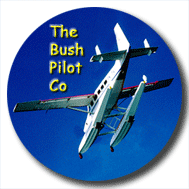 Top of this
page.
Top of this
page.
The
Bush Pilot Company
Last modified on
June 15, 2006 .
© Virtual Horizons, 1996.